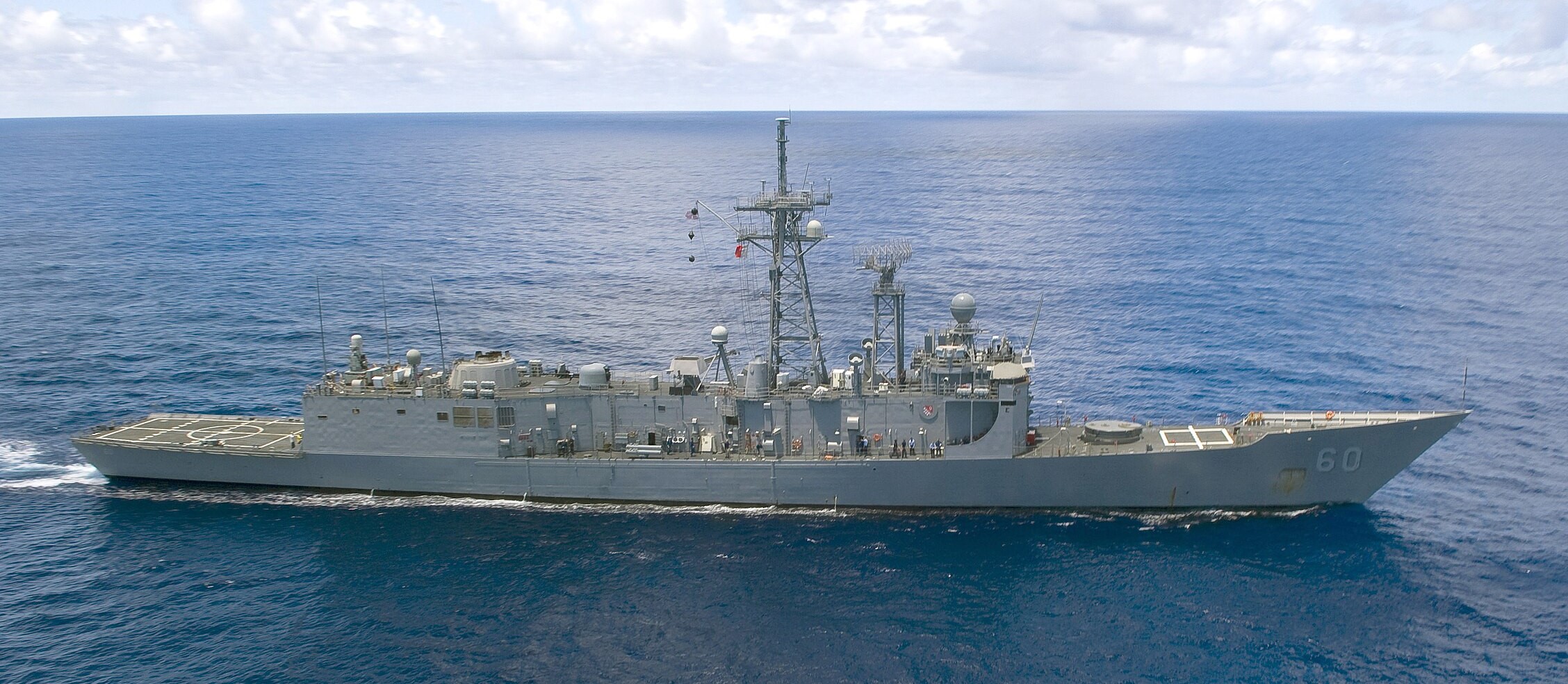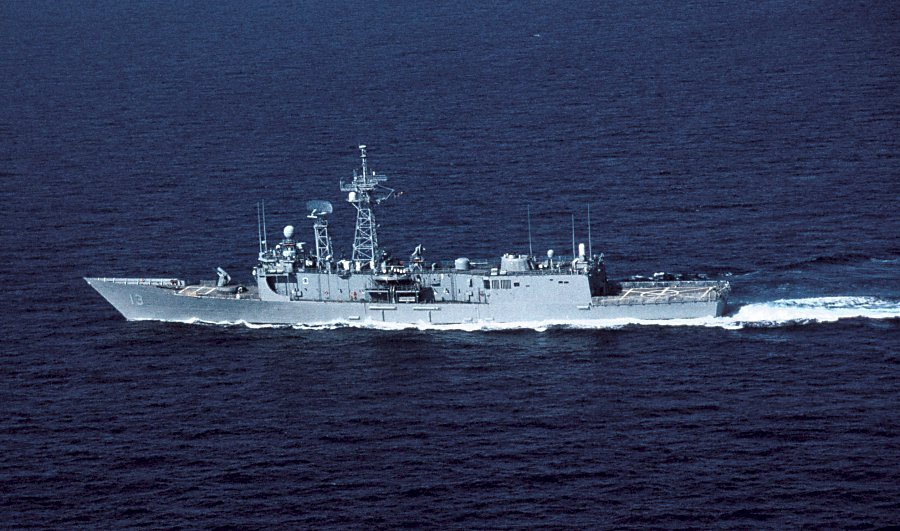In the Naval Gazing Discord recently, there was a discussion of the development of the Oliver Hazard Perry class frigates. Now, it's reasonably well-documented that the initial batch of Perrys were designed to carry the SH-2 Sea Sprite helicopter, but when the SH-60B Seahawk was introduced, the flight deck had to be lengthened to accommodate the bigger helicopter. This was done by extending the stern, which lengthened the hull slightly, bringing overall length from 445' to 453', although waterline length remained constant at 408'.

Rodney M. Davis, a long-hulled Perry showing the sloped stern
But while looking into this, I found a weird discrepancy in the reported displacement. My 1993 copy of Ships & Aircraft of the US Fleet gives the full-load displacement of the short-hull version as 3,658 tons, but says "except 3,900-4,100 tons for ships with LAMPS III modification". Now, this is a big, big jump, particularly towards the upper end of that range, which other sources often extend to 4,200 tons. When you're talking over 10% of initial displacement relative to full load, that's a lot and tends to really screw up the ship. It's rare that the designers leave that much margin, particularly in something like the Perry, which was intended as a pretty austere design. The even bigger question is exactly what was added. The difference between the two designs is fairly obvious if you know what to look for (the short-hulled ships have a pretty much straight stern, while there's a pronounced rake on the long-hulled vessels) but when the length is changing by less than 2% (and it should be a fairly light 2% because it doesn't go below the waterline) and the displacement changes by 10-15%, you start to wonder what is going on. The only other change noted in the books is the towed array, which is an SQR-18 on the short-hull ships and SQR-19 on the long-hulled ships.1 Firm details on the SQR-18 are lacking, but the entire SQR-19 system weighs only 27 tons, so that's out as a cause of the discrepancy.
So I started digging, and came away with the exact same numbers in every source I checked, from other editions of Ships & Aircraft of the US Fleet, to Combat Fleets of the World to a couple of general reference books I happened to find lying around. It's also what the Navy's official fact file gave, so I presume all of these are parroting the Navy's published number. The only place that didn't give a number was Friedman's US Destroyers, because the initial edition was published in the 1982, and while I have the 2004 edition, it's mostly some extra chapters on developments in the intervening years, and the text on the Perrys is, as far as I can tell, exactly the same. Presumably, the displacement numbers for the long-hulled ships hadn't been released yet, which is a pity, because Friedman is the one person who would have thought to ask awkward questions about these kind of things. On the subject, the book says "FFG-7 [Perry herself] came to 3,648 tons fully loaded including a 50-ton service-life margin, and it was expected that FY 79 [LAMPS III] and later ships would exceed 3,700 tons." This implies a gain of 50 to 100 tons, depending on when you apply the service-life margin, which seems like a much more reasonable value for the changes that I have been able to locate.

Samuel Eliot Morison, a short-hulled ship with a vertical stern
To check my work on this, I did some measuring from photos of Stark (short-hulled) and Reuben James (long-hulled), checking the ratio of the height of the hangar to the distance from the upper edge of the hull proper to the upper edge of the black bootstripe.2 The hull was .646x the height of the hangar on Stark and .620x the height of the hangar on Reuben James. Taking the CIWS to be 15.5' high, the result is a hull depth of 12.6' for Stark and 12.1' for Reuben James. In other words, about 6" difference. But we can take this further, thanks to the fact that a long ton (2240 lb) is effectively equivalent to 35 cubic feet of salt water. So if we take the entire waterline footprint of a Perry, 408' long and 45' wide, we get 43.7 tons per inch of immersion. (The real number would obviously be lower, as the ship doesn't fill that entire area.) That implies 262.3 tons as an upper limit on the difference between the two. In reality, there are two other factors. First, the waterplane is smaller because the hull is tapered, particularly forward, so I'd guess the actual tonnage is probably closer to 200. Second, this is fairly far aft, so if the extra weight is concentrated around the helipad in the stern, then the stern will be lower relative to the bow, and the trim change will magnify the apparent tonnage gain derived from this method. I believe that if the weight is about halfway aft from the ship's midpoint (which is conveniently right about where I measured), then you would get effectively twice the dip from weight alone, but I haven't crunched the numbers to double-check that. If that's the case, then the total weight gain is around 100 tons, right around the number given in Friedman. In either case, I could maybe see the actual full-load displacement being the 3,900 tons that is the bottom end of the displacement range for the long-hulled Perry, but even that's 250 tons, and it's really hard to explain where all of that tonnage went. The higher values seem like they're right out.
I write up all of this mostly because I expect it to be interesting to a very small and very geeky section of my audience, and because I found the process interesting, both from an engineering perspective and from how a value like this can remain unquestioned in sources for decades. If anyone has suggestions for finding a better value without going to the National Archives, I'd love to hear it. And who knows. Maybe I go and take a look next time I'm in DC.
1 OK, this isn't quite causal. A number of the Perrys were basically sent straight into the hands of the Naval Reserve once they were completed, with the hopes that they could be activated in wartime. These were most of the short-hulled ships, and the reserve ships got SQR-18, while the active ships received the more-capable SQR-19. ⇑
2 I'm using this rather than the actual waterline because the actual waterline varies a lot with things like how much fuel is onboard, whereas I'd expect the bootstripe to be painted at approximately the same point relative to the full-load waterline on all ships. It's not perfect, and there's potentially quite a lot of error in the system, but short of going to the National Archives, I'm not sure what else to do. ⇑

Comments
That's the Reuben James that gets namechecked in Red Storm Rising, right?
Yes. I often look at ships I know of for other reasons first to make the process of searching for photos easier.
Would asking the Navy be likely to get anywhere?
Probably not. The PAO would be unlikely to have any information I couldn't find, and looking for this kind of stuff isn't really their job. If I could get deep inside NAVSEA, there's probably someone who knows, but with the ships out of service for a decade, I'm not sure who else would.
Just noticed that we're talking about the full load displacement. Is it plausible that the long-hull ships simply load more stuff? An extra 7.5 tons of helicopter obviously, and probably a bunch of helicopter-support stuff to go with that. But if the short-hulled ships went to the reserve fleet and the long-hull ships went to the active fleet, it seems plausible that the short-hulls are carrying displacement numbers based on the stores, munitions, etc, that the designers expected them to be carrying, and the long-hulls are counting all the stuff the designers didn't think of but the operators felt necessary to add.
Does anyone give lightship or standard displacement for the two designs, and if so what does the discrepancy look like there?
Yes, they do, and the discrepancy is the same. I thought I said that, but if not, I did check that in IIRC Combat Fleets.
I went and checked Polmar, and he has a bigger gap in light displacement than in loaded displacement, which sort of agrees with your theory, but still leaves me wondering where all the weight is. 7.5 tons of helicopter isn't nothing, but it's like 5% of the minimal difference, and they aren't carrying dozens of helicopters.